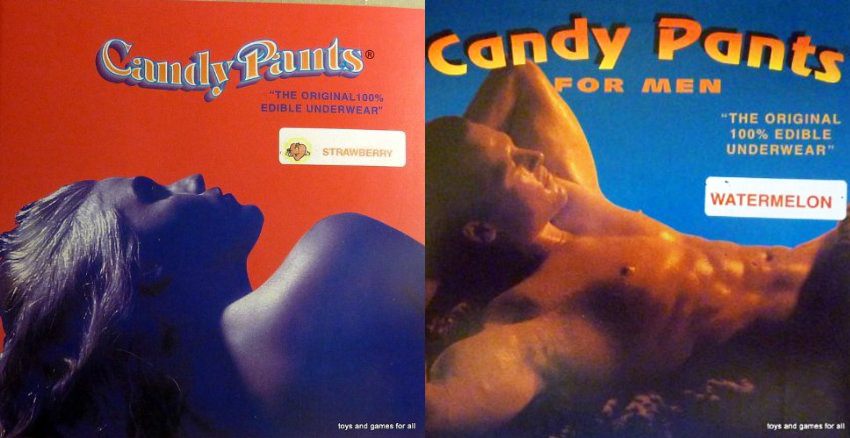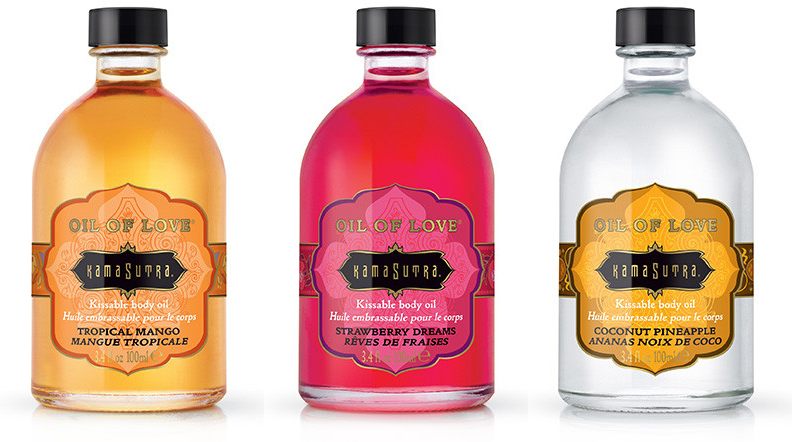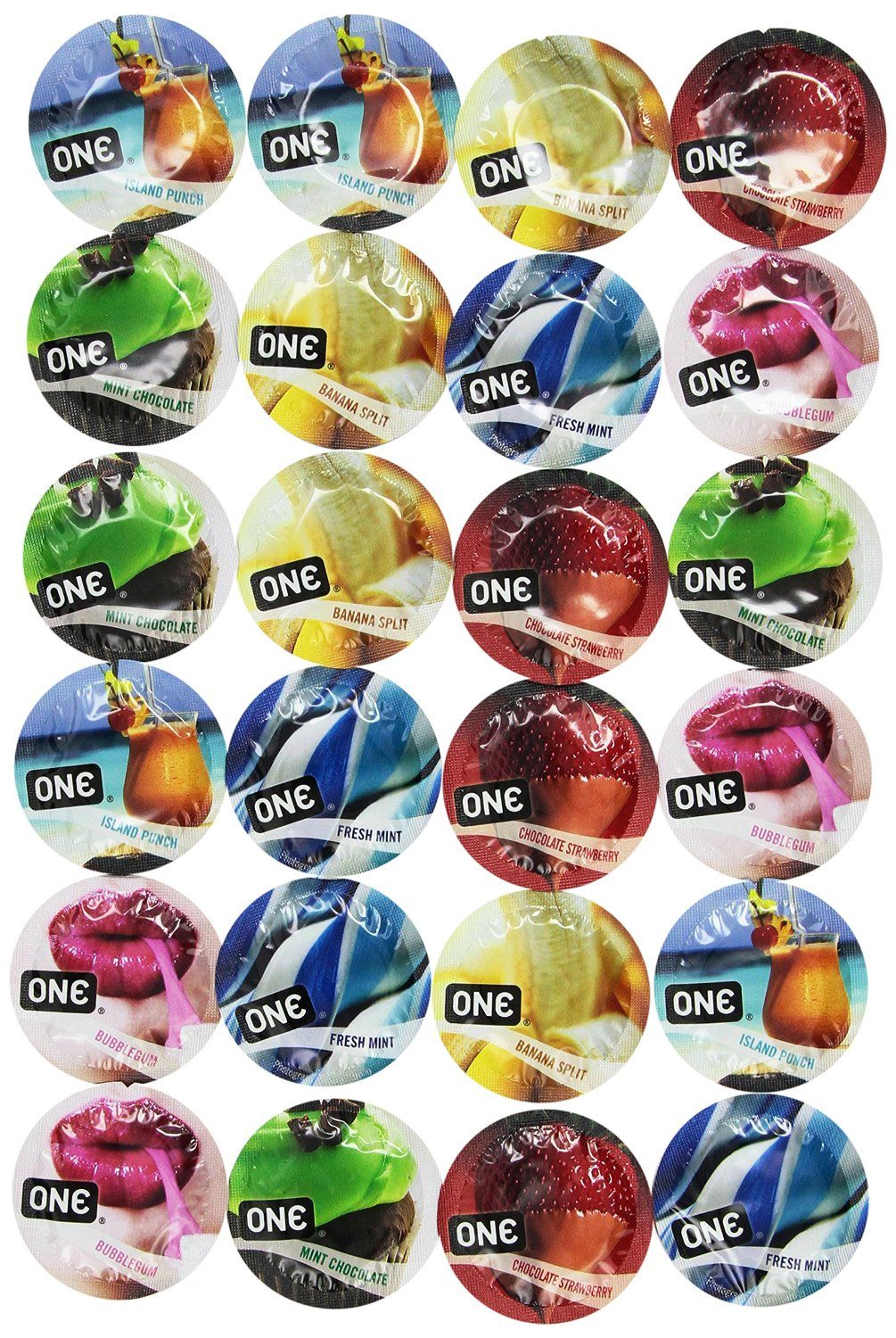A Matter of Taste: Inside the Edible Sex Toy Industry

His and Hers Candypants, in strawberry and watermelon flavor. (Photos: Amazon)
Eating and sex have a lot in common: they’re both necessary human activities that we’ve managed to find pleasure in. With both there’s a concern about contamination and purity; use of orifices; mixed metaphors around consumption like being “sex starved” and multiplicity of meanings of words like “eat” and “meat”. Freud found them to be twin drives. Modern researchers study their shared addictive qualities.
Yet, food and sex rarely literally meet, as the notion of integrating food into sex seems to touch upon some deep revulsion. The flavors of chocolate and bodily fluids just don’t mix. Chewing while in the throes of passion? No thanks.
Perhaps this is why the edible sex accessory industry has remained a mere novelty. This small pocket of the sex industry is responsible for a bevy of products like edible underwear, chocolate body paint, and flavored lube, products that are typically given as joke presents rather than serious sex accessories.
Edible sex accessories began in the heady days of the sexual revolution of the ’60s. When they began, every sexual device was relegated to seedy sex stores, or billed as having more respectable uses (think “home massager” instead of “vibrator.”) Even the term “sex toy” is a coy dodge: “We displaced the awkwardness of using machines as sexual aids by turning these aids into novelty objects, or toys,” writes Hannah Smothers for Fusion. But a new crop of expertly engineered, elegantly designed vibrators and dildos is helping to elevate these products into something of a standard home appliance. Are edible sex products going in the same direction, or are they doomed to bachelorette party hell for eternity?
Early sexual lubricants were naturally flavored, because most of them were also foods. Olive oil and aloe were natural choices, and supposedly so was a slippery substance that comes from grating Chinese yam. But these were used as sexual necessities—aloe may taste nice, but the point was its function, not its flavor. It’s not hard to imagine that many people may have incorporated edibles into their lovemaking, but to mark the beginning of edible sex products as an industry, we go to 1969. (Nice.)
The first flavored sex product came out of a wild 1960s party, where Hal Hauser and Joe Bolstad were “getting crazy, and people were getting into Wesson oil,” according to Marla Lee, the President of Kama Sutra, the company they’d eventually found. The men, who were in the advertising business, “were talking about [the Wesson oil] later…and saying that it just doesn’t taste good. It’s slippery but, we can make it better.” Perhaps because they were advertisers, the product came with a lifestyle mission – and a name, Kama Sutra, inspired by the idea that they were bringing back the rituals and sensual experience of lovemaking. “The country was in a bit of despair at the time, and people were searching for something better in their lives,” says Lee. “So they started writing out this copy about this oil, that they had not even formulated yet.” As Hauser put it in a Los Angeles Times interview in 1986, “There was a need at the time for people to touch each other on all levels, this being the most obvious level approaching it.”

A Spencer’s Gift Shop, home to novelty gifts for Bachelorette parties. (Photo: Ildar Sagdejev/WikiCommons CC BY-SA 3.0)
Out of that idea came the first edible-on-purpose product, the Oil of Love. It’s described as a “kissable, water-based foreplay oil,” the original flavor of which combined notes of cinnamon, cardamom, vanilla, and chocolate, and which features a warming sensation on the skin. The company quickly expanded with flavored “honey dust” and various massage oils, designed to “startle your sense of touch without offending your sense of taste,” according to a 1971 ad in Women’s Wear Daily.
That ad shows the precarious market position of products like Oil of Love. The early 70s were a changing time for sexual attitudes. The Joy of Sex, published in 1972, formalized an increasing openness in speaking about sexual enjoyment and preferences. Plus, the Kama Sutra name tapped into the Indian orientalism sweeping America. But as much as the sexual revolution marched on, it was a different story when it came to sexual retail. “They were very limited on where the product could be sold and who was willing to have this very racy product,” says Lee. Aside from ads filled with euphemisms and trade shows, Kama Sutra’s products had to be sold in sex shops, where many were still too squeamish to shop.
This squeamishness is part of what began to cement edible products as novelties. They just couldn’t hold shelf space in “respectable” stores, even next to scented lotions or lingerie, if their intent was obviously sexual pleasure. To get into Bloomingdale’s, the edible sex products had to be designed specifically as jokes.
Candypants, the original edible underwear, is a great example of this kind of joke product, and its history is full of technological ingenuity, bizarre court cases, and even spies. The concept was dreamed up in 1972 by Lee Brady and David Sanderson, a couple of artists living in Chicago, who created the undies as a piece of concept art. “My brother always used to say to me ‘oh eat my shorts,’ for ‘fuck off’ basically,” says Sanderson. “And we were sitting around one night, thinking we should come up with something as a joke. And we did.” They made a quick prototype and threw it up in the window of a friend’s shop as a “decorative topic of conversation,” but it ended up being sold to a student at the University of Indiana, who worked for the local paper that had AP syndication. She wrote about it, and through the wire service Candypants became a literal overnight sensation.

Different flavors of Kama Sutra’s Oil of Love. (Photo: Courtesy Kama Sutra)
Brady and Sanderson prided themselves on producing a product that, were you to eat it, would actually be tasty. Their search for a suitable material that would hold its shape like fabric led them to a few different experimental labs, and eventually to an industrial baking company. “The company would make a bag out of [this material] and fill it with yeast and throw it in a vat with liquids,” says Brady. “It was biodegradable and edible, so it would dissolve in the vat.” It was also colorless and tasteless, which meant they could build flavor into it. It took them months to develop the first packaged product, but eventually they built up a factory of 40 employees, and expanded their line to include new flavors and the “Teacups” edible bra.
Unlike Oil of Love, the Candypants marketing strategy did not position this as a product that would bring couples closer together through sensuality. It was an exquisitely engineered gag. The original displays in stores like Bloomingdale’s and Montgomery Ward featured a poster of an old woman with bright red nail polish holding boxes of panties, while the flip side featured a young woman wearing Candypants products. “We were aware that we had two different audiences,” says Brady. Their goal was to make it “naughty and nice,” hinting at what could be done in the bedroom but keeping it light and funny. To stay respectable, they had to stay a novelty.
The success of Candypants proved that there was a market for such novelties, and competitors began to spring up, some which leeched off their supplier. “They saw money coming from somebody other than us, so they started short shipping our supplies,” says Brady. Desperate for a new material, the Candypants founders took a tip from their friend Tokyo Rose, aka Iva Toguri D’Aquino, who had been charged with treason after being suspected of aiding Japanese Axis forces during WWII. At the time, she ran a mercantile exchange in Chicago, and told Brady and Sanderson about a 400 year old factory in Japan that made rice paper for candy wrappings and as a vehicle for medication (in place of the gel caps found commonly in the West). The pair traveled to Japan and struck a deal with the factory—which made, according to them, a superior product. (While they were at it, they also developed “Mighty Mouth,” a dissolving breath strip. It never caught on, but when Listerine breath strips hit the market, they had their suspicions about the inspiration.)

Coupons for Wesson Oil, an early form of lubricant. (Photo: frankieleon (cropped)/flickr)
Candypants also became a cultural touchpoint for sexual liberation, used as proof that as a society we were ready to stop hiding our sexual proclivities. They were even used as evidence in a number of free speech lawsuits. “When cable first started there was this show in New York called Midnight Blue, which at one point featured a black girl taking a bite out of a pair that a white guy was wearing,” explains Sanderson. “And they banned the show and tried to close it down, and it went all the way to the U.S. Supreme Court, and we were Exhibit A for First Amendment rights for freedom of speech. And we won.”
After nearly 10 years, Brady and Sanderson wanted to move on to other projects, and were offered a deal to sell the company. A creepy deal, but a deal: “They sent somebody from Las Vegas, of course, and exchanged a suitcase full of cash. We were so paranoid that we immediately went to a bank and deposited it,” says Brady. Throughout the company’s life, though, Candypants never shed its novelty product status. “We did some market surveys, and about 85 percent of buyers would never even open the box,” says Sanderson.
By the 1980s the edible underwear market was starting to plateau. A slew of competitors had cropped up, many of lesser quality, while some manufacturers realized they could cross into more mainstream categories. In 1986, Kama Sutra launched a lingerie line. “Part of the reason for the shift, Bolstad says, is a leveling off of demand for its oils, creams and powders,” wrote the LA Times. “Kama Sutra sold $2 million worth of the products last year and company officials believe that’s close to the market’s limit.” The company even began distancing itself from the lickable sex products of its past, focusing more on scent than taste. By 1996, scented body products and aromatherapy oils were going mainstream, and Kama Sutra was producing tame new lines of bath gels and candles.
Around this same time, though, the Achilles heel of edible products–the fact that they were still, fundamentally, a silly joke—became a strength.. More people were becoming aware of the AIDS epidemic, and sex was getting a dangerous image. Many companies looked for ways to prove, with their products, that sex could be fun and safe at the same time. In 1988, Lifestyles introduced its “Kiss of Mint” condoms, and in 1995, Durex introduced its first line of flavored condoms, which it still produces today. While Durex marketing director Karen Chisholm says the company’s current line of flavored condoms (“Tropical” flavored) are “intended primarily for vaginal sex,” it’s likely that they were first introduced as a way to spice up safe oral sex.

Flavored condoms for sale on Amazon. (Photo: Amazon)
Flavored condoms are still being sold. According to Durex, sale of the Tropical line “has been growing 30-40% vs. prior year.” However, it’s unclear how many of these sales are repeat customers, and how many are teenagers buying them for a one-time experiment or laugh. And at least according to Amazon reviews, various brands of flavored condoms function just fine, but the flavor is still lacking. “They smell good, they taste ok but the mint flavors are too strong and make me have a really unpleasant tingle/ burning feeling,” says one reviewer of ONE Flavor Waves condoms.
That’s partly because it’s hard to balance taste with safety. The ingredients that bring flavor (sucrose, sodium saccharin, aspartame) can also cause yeast infections – or lead to genital irritation, which means figuring out an awkward way to change products in the middle of a sexual encounter. “When you’re having an intimate experience with your partner, the last thing you want is to run to the bathroom to wash something off,” says Lee.
The ideal flavored sexual product is one that can be used safely on (and in) all areas of the body, and that actually tastes good. This is the brass ring the industry has been chasing since 1969, and one that seems increasingly appealing in our artisanal food- driven world. What’s the good of flavored body paint if you have to wash it off before you have sex, but also, what’s the point of flavored body paint if it tastes like artificial banana? The general public has become pickier about good taste. We have aioli on Wendy’s sandwiches and want our ingredients to be organic and naturally sourced. Why would that change when it comes to products we’re licking off each other?
Kama Sutra may be closer than ever to developing that ideal product. Right now, they have products like the “body souffle,” which they have to remind customers not to use as actual cake frosting, and a “body glide” that is safe for genital use but doesn’t have a particularly strong flavor. They’re currently in the testing stages of a product that could combine both: a massage gel that’s “completely kissable” and safe for intercourse.
It’s still an open question, however, whether a product like this could take the edible sex industry out of the novelty retail space. The idea of these products as a bachelorette staple generally confuses Lee, who wonders why newlyweds need tasty additions to their love lives: “Why waste the product on that segment? They’re high on love! It’s fresh, it’s new, it’s exciting.” Kama Sutra envisions these products being for couples down the line, when sex is no longer new, when something else needs to be introduced to break up the monotony. But can potential customers be persuaded to take edible products seriously as marital aids, when they’ve become so accustomed to seeing them as a joke? There’s a big step between sharing a laugh at a jar of chocolate body paint and actually asking your partner to use it.
If there were any time for a boom in the edible sex accessory industry, it’s now. We’re more open and enthusiastic about owning sex toys than ever, and at the same time, we’re increasingly concerned with food. Perhaps, like the sex toy industry, the edibles industry will rebrand itself with high-end products at high-end prices: farm-to-table massage oils, fair-trade fruit leather bras, soylent pasties. Perhaps it will go local, every city with its own artisanal edible panties startup.
Or perhaps there is only so far sex and food can intersect. Eating, after all, is not sexy. For every movie shot of a beautiful woman deep-throating a banana, there’s one we don’t see of her biting down. And for all we wish we could overcome our inhibitions, sex is often embarrassing enough without the addition of mastication. Of the two sides of edible sex accessories – those designed to bring us closer together, and those designed to make us laugh–the gags are still winning. At least they all taste pretty good.








Follow us on Twitter to get the latest on the world's hidden wonders.
Like us on Facebook to get the latest on the world's hidden wonders.
Follow us on Twitter Like us on Facebook